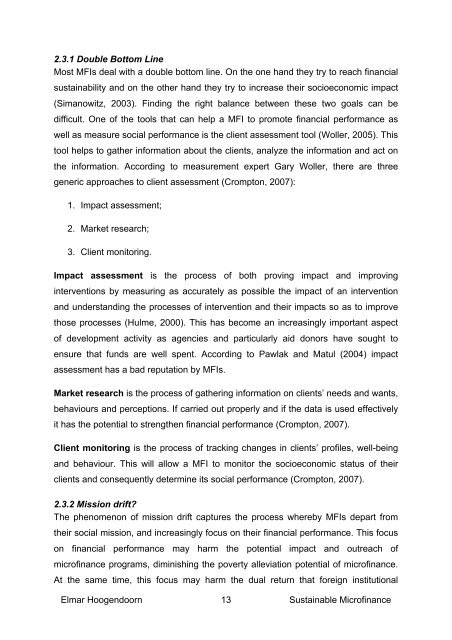Sustainable Microfinance - Balanced Scorecard's added value for ...
Sustainable Microfinance - Balanced Scorecard's added value for ...
Sustainable Microfinance - Balanced Scorecard's added value for ...
You also want an ePaper? Increase the reach of your titles
YUMPU automatically turns print PDFs into web optimized ePapers that Google loves.
2.3.1 Double Bottom Line<br />
Most MFIs deal with a double bottom line. On the one hand they try to reach financial<br />
sustainability and on the other hand they try to increase their socioeconomic impact<br />
(Simanowitz, 2003). Finding the right balance between these two goals can be<br />
difficult. One of the tools that can help a MFI to promote financial per<strong>for</strong>mance as<br />
well as measure social per<strong>for</strong>mance is the client assessment tool (Woller, 2005). This<br />
tool helps to gather in<strong>for</strong>mation about the clients, analyze the in<strong>for</strong>mation and act on<br />
the in<strong>for</strong>mation. According to measurement expert Gary Woller, there are three<br />
generic approaches to client assessment (Crompton, 2007):<br />
1. Impact assessment;<br />
2. Market research;<br />
3. Client monitoring.<br />
Impact assessment is the process of both proving impact and improving<br />
interventions by measuring as accurately as possible the impact of an intervention<br />
and understanding the processes of intervention and their impacts so as to improve<br />
those processes (Hulme, 2000). This has become an increasingly important aspect<br />
of development activity as agencies and particularly aid donors have sought to<br />
ensure that funds are well spent. According to Pawlak and Matul (2004) impact<br />
assessment has a bad reputation by MFIs.<br />
Market research is the process of gathering in<strong>for</strong>mation on clients’ needs and wants,<br />
behaviours and perceptions. If carried out properly and if the data is used effectively<br />
it has the potential to strengthen financial per<strong>for</strong>mance (Crompton, 2007).<br />
Client monitoring is the process of tracking changes in clients’ profiles, well-being<br />
and behaviour. This will allow a MFI to monitor the socioeconomic status of their<br />
clients and consequently determine its social per<strong>for</strong>mance (Crompton, 2007).<br />
2.3.2 Mission drift?<br />
The phenomenon of mission drift captures the process whereby MFIs depart from<br />
their social mission, and increasingly focus on their financial per<strong>for</strong>mance. This focus<br />
on financial per<strong>for</strong>mance may harm the potential impact and outreach of<br />
microfinance programs, diminishing the poverty alleviation potential of microfinance.<br />
At the same time, this focus may harm the dual return that <strong>for</strong>eign institutional<br />
Elmar Hoogendoorn 13<br />
<strong>Sustainable</strong> <strong>Microfinance</strong>
















![Joint Report on Social Protection and Social Inclusion [2005]](https://img.yumpu.com/19580638/1/190x132/joint-report-on-social-protection-and-social-inclusion-2005.jpg?quality=85)
